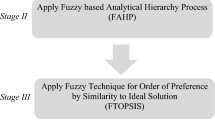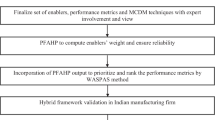Abstract
Swift growth in industry and continuously increasing competitiveness around the world have necessitated the industries to adopt new paradigms. In today’s competitive scenario, all firms need to be more efficient, responsive, reliable, resilient, and sustainable. The need for the adoption of these paradigms has increased manifold due to the current pandemic. In the current situation where the Supply Chains (SC) all over the world are affected, a strategic and innovative rethinking is required by the business community to conduct their operations smoothly. For this purpose, simultaneous adoption of a combination of Lean, Agile, Resilient, and Sustainable (LARS) practices may provide the expected result. The consolidated execution of these four different practices on the existing SC will result in huge benefits from a strategic perspective since (i) lean focuses on minimizing cost and elimination of waste, (ii) agility results in fast response to customer demands, (iii) resilience focuses on the longevity of the SC, and (iv) sustainability is achieved by adopting triple bottom line (TBL) approach. However, there are numerous barriers which make it difficult to implement the LARS paradigms jointly in any SC. The aim of the present study is to identify and determine the inter-relationships between various barriers and classify them into “cause” and “effect” groups. An Integrated Multi-Criteria Decision-Making (MCDM) approach has been used for the analysis of barriers, and the fuzzy set theory has been used to deal with the uncertainty in terms of vague and imprecise available information. The fuzzy-Delphi method has been used for the selection of critical barriers by taking experts’ opinions. The fuzzy Decision-Making Trial and Evaluation Laboratory (Fuzzy-DEMATEL) method is used to find relationships between the barriers, highlighting the hidden dependencies between them which provides a clear understanding of the areas which should be carefully planned while adopting LARS paradigms in SCM. The findings of the present analysis can be used by practitioners of any industry.
Access this chapter
Tax calculation will be finalised at checkout
Purchases are for personal use only
Similar content being viewed by others
References
Agarwal A, Shankar R, Tiwari MK (2006) Modeling the metrics of lean, agile and leagile supply chain: an ANP-based approach. Eur J Oper Res 173(1):211–225
Womack JP, Jones DT, Roos D (2007) The machine that changed the world: the story of lean production–Toyota’s secret weapon in the global car wars that is now revolutionizing world industry. Simon and Schuster
Gunasekaran A, Patel C, McGaughey RE (2004) A framework for supply chain performance measurement. Int J Prod Econ 87(3):333–347
Panizzolo R (1998) Applying the lessons learned from 27 lean manufacturers: the relevance of relationships management. Int J Prod Econ 55(3):223–240
Sanchez LM, Nagi R (2001) A review of agile manufacturing systems. Int J Prod Res 39(16):3561–3600
Blome C, Schoenherr T, Rexhausen D (2013) Antecedents and enablers of supply chain agility and its effect on performance: a dynamic capabilities perspective. Int J Prod Res 51(4):1295–1318
Gligor DM, Esmark CL, Holcomb MC (2015) Performance outcomes of supply chain agility: when should you be agile? J Oper Manag 33:71–82
Zobel CW (2011) Representing perceived tradeoffs in defining disaster resilience. Decis Support Syst 50(2):394–403
Blackhurst J, Dunn KS, Craighead CW (2011) An empirically derived framework of global supply resiliency. J Bus Logist 32(4):374–391
Pettit TJ, Fiksel J and Croxton KL (2010) Ensuring supply chain resilience: development of a conceptual framework. J Bus Logist 31(1):1–21
Closs DJ, Speier C, Meacham N (2011) Sustainability to support end-to-end value chains: the role of supply chain management. J Acad Mark Sci 39(1):101–116
Linton JD, Klassen R, Jayaraman V (2007) Sustainable supply chains: an Introduction. J Oper Manag 25(6):1075–1082
Yaakub S, Mustafa HK (2015) Supply chain risk management for the SME’s. Acad J Interdiscip Stud 4(1 S2):151
Cabrita M, Duarte S, Carvalho H, Cruz-Machado V (2016) Integration of lean, agile, resilient and green paradigms in a business model perspective: theoretical foundations. IFAC-PapersOnLine 49(12):1306–1311
Rachid B, Roland D, Sebastien D, Ivana R (2017) Risk management approach for lean, agile, resilient and green supply chain. World Acad Sci Eng Technol Int J Soc Behav Educ Econ Bus Ind Eng 11(4):742–750
Carvalho H, Azevedo S (2014) Trade-offs among lean, agile, resilient and green paradigms in supply chain management: a case study approach. In: Proceedings of the seventh international conference on management science and engineering management, Springer, Berlin, pp 953–968
Cherrafi A, Elfezazi S, Reyes JA, Benhida K, Mokhlis A (2017) Barriers in Green Lean implementation: a combined systematic literature review and interpretive structural modelling approach. Prod Plan Control 28(10):829–842
Rajesh R (2018) Measuring the barriers to resilience in manufacturing supply chains using Grey Clustering and VIKOR approaches. Measurement 126:259–273
Sindhwani R, Malhotra V (2015) Lean and agile manufacturing system barriers. Int J Adv Res Innov 3(1):110–112
Nidumolu R, Prahalad CK, Rangaswami MR (2009) Why sustainability is now the key driver of innovation. Harv Bus Rev 87
Jack EP, Powers TL, Skinner L (2010) Reverse logistics capabilities: antecedents and cost savings. Int J Phys Distrib Logist Manag 40:228–246
Kumar A (2014) A qualitative study on the barriers of lean manufacturing implementation: an Indian context (Delhi ncr region). Int J Eng Sci 3(4):21–28
Bajjou MS, Chafi A (2018) Barriers of lean construction implementation in the Moroccan construction industry. In: AIP conference proceedings, vol 1952, No 1. AIP Publishing LLC, p 020056
Vachon S, Klassen RD (2007) Supply chain management and environmental technologies: the role of integration. Int J Prod Res 45:401–423
Latif AZ, Malkh HN, Khalidi A (2019) Impact of supply chain governance on financial reporting: evidence from Iraq. Int J Supply Chain Manag 8(1)
Martek I, Hosseini MR, Shrestha A, Edwards DJ, Durdyev S (2019) Barriers inhibiting the transition to sustainability within the Australian construction industry: an investigation of technical and social interactions. J Clean Prod 211:281–292
Biddle J (2006) The lean benchmark report-closing the reality gap. Aberdeen Group. www.synergyresources.net/pdf/ra_lean_wp.pdf. Accessed 1 June 2012
Aid G, Eklund M, Anderberg S, Baas L (2017) Expanding roles for the Swedish waste management sector in inter-organizational resource management. Resour Conserv Recycl 124:85–97
Turker D, Altuntas C (2014) Sustainable supply chain management in the fast fashion industry: an analysis of corporate reports. Eur Manag J 32:837–849
Jadhav JR, Mantha SS, Rane SB (2014) Exploring barriers in lean implementation. Int J Lean Six Sigma 5(2):122–148
Wang Z, Mathiyazhagan K, Xu L, Diabat A (2015) A decision making trial and evaluation laboratory approach to analyze the barriers to Green Supply Chain Management adoption in a food packaging company. J Clean Prod
Moktadir MA, Ali SM, Rajesh R, Paul SK (2018) Modeling the interrelationships among barriers to sustainable supply chain management in leather industry. J Clean Prod 181:631–651
Kumar R, Kumar V (2014) Barriers in implementation of lean manufacturing system in Indian industry: a survey. Int J Latest Trends in Eng Technol 4(2):243–251
Chaple AP, Narkhede BE, Akarte MM, Raut R (2018) Modeling the lean barriers for successful lean implementation: TISM approach. J Lean Six Sigma, Int
Yukalang N, Clarke B, Ross K (2017) Barriers to effective municipal solid waste management in a rapidly urbanizing area in Thailand. Int J Environ Res Public Health 14(9):1013
Govindan K, Kaliyan M, Kannan D, Haq AN (2014) Barriers analysis for green supply chain management implementation in Indian industries using analytic hierarchy process. Int J Prod Econ 147(B):555–568
Li Y (2014) Environmental innovation practices and performance: moderating effect of resource commitment. J Clean Prod 66:450–458
Johansson F, Rusu L (2019) Barriers to agility in a large company’s IT organization. Int J Innov Digital Econ (IJIDE) 10(1):1–17
Lin CT, Chiu H, Chu PY (2006) Agility index in the supply chain. Int J Prod Econ 100(2):285–299
Dubey R, Gunasekaran A (2015) Shortage of sustainable supply chain talent: an industrial training framework. Ind Commer Train 47:86–94
Christopher M (2000) The agile supply chain, competing in volatile markets. Ind Mark Manag 29:37–44
Potdar PK, Routroy S, Behera A (2017) Analyzing the agile manufacturing barriers using fuzzy DEMATEL. Benchmarking Int J 24(7):1912–1936
Singh PK, Sarkar P (2020) A framework based on fuzzy Delphi and DEMATEL for sustainable product development: a case of Indian automotive industry. J Clean Prod 246:
Author information
Authors and Affiliations
Editor information
Editors and Affiliations
Rights and permissions
Copyright information
© 2021 The Author(s), under exclusive license to Springer Nature Singapore Pte Ltd.
About this paper
Cite this paper
Barua, D., Jain, A., Jain, V. (2021). An integrated Fuzzy MCDM Approach for Evaluation of Barriers in Implementing LARS Paradigms in Supply Chain. In: Tiwari, A., Ahuja, K., Yadav, A., Bansal, J.C., Deep, K., Nagar, A.K. (eds) Soft Computing for Problem Solving. Advances in Intelligent Systems and Computing, vol 1393. Springer, Singapore. https://doi.org/10.1007/978-981-16-2712-5_52
Download citation
DOI: https://doi.org/10.1007/978-981-16-2712-5_52
Published:
Publisher Name: Springer, Singapore
Print ISBN: 978-981-16-2711-8
Online ISBN: 978-981-16-2712-5
eBook Packages: Intelligent Technologies and RoboticsIntelligent Technologies and Robotics (R0)




